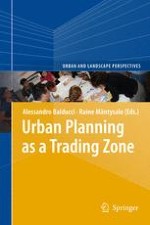2013 | OriginalPaper | Chapter
5. SoftGIS Development Process as a Trading Zone: Challenges in Implementing a Participatory Planning Support System
Author : Maarit Kahila-Tani
Published in: Urban Planning as a Trading Zone
Publisher: Springer Netherlands
Activate our intelligent search to find suitable subject content or patents.
Select sections of text to find matching patents with Artificial Intelligence. powered by
Select sections of text to find additional relevant content using AI-assisted search. powered by
